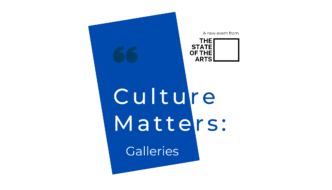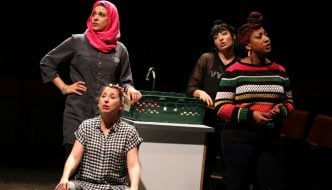
Still from Survivor, Reija Merilainen, 2017. Image courtesy of the artist
In its new exhibition States of Play: Roleplay Reality, Liverpool’s FACT has set out to explore an idea which is full of potential: using existing platforms to create new, virtual identities for ourselves and others. Through the eyes of other people’s attempts at roleplay, the works explore various themes, from social isolation and poverty, to sexism in the software industry and racial bias in games. The central focus of the exhibition, however, is on the ability of modern technology to create a state of immersion which, sadly, States of Play, fails to pull off. Unfortunately, not all of the works were in working condition when I visited on a Sunday afternoon, seemingly visitor prime time. About 40% of the pieces were either broken or not working as intended. For a ‘Foundation of Technology’ this is, quite simply, a failure.
The design of Gallery 1 is a curious experiment, with sand and water cushioning the floor, an abundance of reflective surfaces, floating walls and foam that resembles pink concrete to sit on. The unexpected sensory experience of walking on sand indoors is a pleasant built up to the titular immersion, whilst the fake concrete may be a nod to the security of the game realm.
The exhibition guide suggests that the design sets out to make you doubt where the real world ends and the virtual one begins but unfortunately, that’s not the case. In fact, the centrepiece of the room, David O’Reilly‘s ‘Everything’ game (2016), is projected over three large screens and should be a playable exhibit. Unfortunately, at the time it was a chaotic ‘trailer’ that left the viewers scratching their heads. A quick chat with the gallery assistant explained that the controllers had to be taken away because sand got inside them. Reality gets a little too real and the potentially fascinating virtual experience is not attainable.
One of the most interesting pieces in the gallery is also the simplest. Propentine Charity Heartscape‘s ‘Howling Dogs‘ (2012) is a text adventure game which is enticing through the beauty of the language used. It is nostalgic in style and alludes to the idea of virtual imprisonment. It’s a short, simple and almost immersive experience.
Gallery 2 greets visitors with a warning sign of the violent imagery ahead. The ‘Open Heart Warrior’ installation (2016) by Jon Rafman consists of a three-channel video and a spa-style chair. The video juxtaposes scenic, high-definition landscapes sourced from various games with scenes of violence and mutilation. This is experienced surrounded by a calming voice, instructing the viewer to relax. The combination of the sound, enveloping visuals and the comfortable seat is indeed immersive, and while the extreme contrasts between the images remain mildly intriguing, there is another layer to this piece. Inspired by spa architecture, it lures you in by creating the appearance of a custom-made experience, with only enough space for one – you. It raises some unsettling questions about the nature of manipulation through immersion and how dangerously close the virtual experience comes to what would normally be a process of relaxation rooted in the sensual.
Once again, a number of works in Gallery 2 were ‘out of order’ but the highlight of the show was ‘Real Violence‘ (2016) by Jordan Wolfson. This is a VR film, which, as soon as you squeeze into the headset, pushes you directly into a scene of visceral violence: a baseball bat street execution – one that goes beyond even the most extreme viral YouTube videos. Although only one headset was working, the extremes of emotion elicited by the piece are immersion enough. Close your eyes, take off the headset, or bear it until the end, but don’t expect a happy ending.
States of Play: Roleplay Reality is a show full of contrasts. The fact that so much of the technology did not function properly raises the profile of those works which were working, and triggered a strong emotional response alongside the relief felt when putting on a headset that doesn’t display an error message. Unfortunately, FACT did their artists a great disservice by not preparing for the technical challenges such a show poses. What could have been an exploration of virtual possibility was let down by the lack of technological preparation. The show strived for a second virtual life, while failing to turn on the screens.
Filed under: Art & Photography
Tagged with: David O'Reilly, Everything (2016), exhibition review, FACT, Howling Dogs (2012), Immersive Art, Jon Rafman, Jordan Wolfson, liverpool, Open Heart Warrior installation, Propentine Charity Heartscape, Real Violence (2016), Roleplay, States of Play: Roleplay Reality, Virtual Reality, VR, What's On



Comments